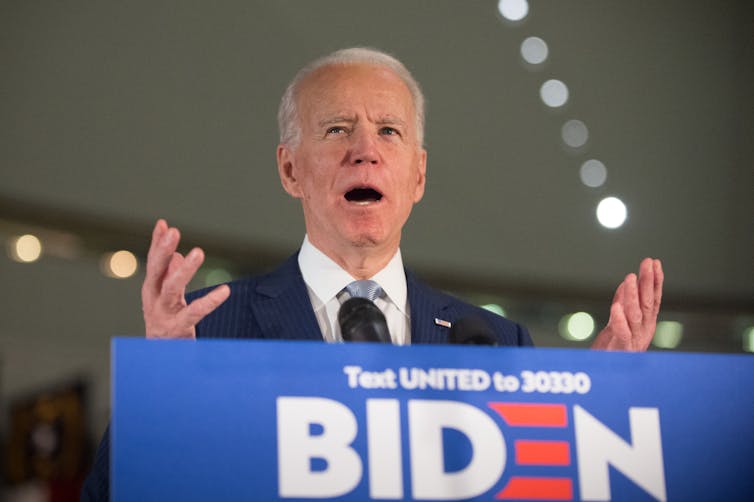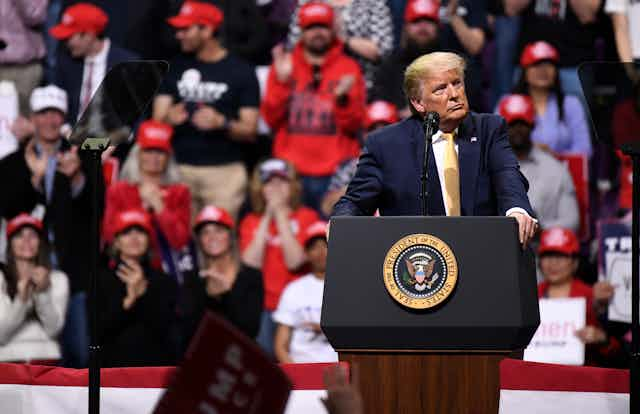President Donald Trump’s approval ratings have dropped again after a brief uptick that prompted widespread claims of a “rally round the flag” effect in late March.
It’s wise not to read too much into the implications of these rating movements for the US presidential elections in November. The basic electoral dynamics have not changed since the Republican’s heavy losses in the 2018 midterm elections, and actually not much since Trump’s marginal victory in the 2016 presidential race.
The uptick in approval ratings in late March was neither unprecedented for Trump, nor was it large or long lasting: 49%, up from 44% in early March, and back down to 43% in early May. Trump’s approval went up to 49% in January and February when he was being tried in the Senate. However, since Trump’s inauguration his approval has consistently bumped along in the low 40% range.
Meanwhile, some approval polls, including some taken in mid and late-March when Trump’s rating rose, were not confined to samples of likely voters but rather polled all adults, which also included non-voters, many of whom are not even registered. This distinction is important because only 55%-60% of the US voting age population go out to vote in presidential elections.
Trump’s uptick in approval came in the early stages of the coronavirus outbreak in the US. It was really very small in historical perspective – especially when compared with rallies round the flag during previous international and national crises. Just before 9/11, for example, George W Bush was on 51.5% approval but then soared to 88.4% after.
Read more: How the coronavirus economic crisis could hit Donald Trump's re-election prospects
Trump remains vulnerable
The basic dynamics of the election remain the same as they have been for the past year or so: Trump might win re-election in November but it’s still more likely that Joe Biden, the former vice-president and expected Democratic party nominee, will become the next president.
The combination of Trump’s marginal 2016 victory, losing the House of Representatives in the 2018 midterm elections, and his unimpressive approval ratings as president in comparison with all his predecessors since Harry Truman have always made Trump electorally vulnerable to any negative developments.
Several factors could have changed the 2020 electoral landscape: disunity in the Democratic Party, a good economy, and an impressive response to the COVID-19 crisis. Either they have not, or are unlikely to change it now.
Rather, each of these factors has now changed in Biden’s favour, at the same time that Trump’s electoral vulnerabilities remain or have increased. Recall that his 2016 Democratic opponent Hillary Clinton lost three battleground states – Michigan, Pennsylvania and Wisconsin – by just 1%. If she had won each those states, she would be president.
An Ipsos poll taken in mid-April showed registered voters in those three states favouring Biden over Trump, 45% to 39%. This was at a time when Biden was sidelined in the COVID-19 crisis while Trump dominated public attention. The poll found that 48% of people living in those states said the coronavirus was the most important problem facing their community, way ahead of other issues. A Fox News poll of voters in the battleground states of Florida, Michigan, and Pennsylvania showed similar results.
National polling data show that Trump has failed to extend his 2016 electoral coalition of white evangelicals, rural voters, conservatives, self-identified Republicans, and white men who didn’t go to college. They also show that college-educated white people (especially women) and older voters are shifting to the Democrats, as they did in the 2018 midterm elections.
Rally behind Biden
While Trump’s electoral vulnerability has increased, Biden’s has decreased. After his opponent Bernie Sanders withdrew from the Democratic primary, he announced his support for Biden, adding to the endorsement of other former Democratic candidates. The widespread fear that the Democrats would be divided in a nasty primary fight disappeared surprisingly quickly – and without Biden being pulled too much to the left of the political centre.

Biden’s message exudes pragmatism and gradual change – on healthcare, climate change, guns and economic inequality, which will likely appeal to many independents and centrist voters. And, come the election, polls show most Sanders Democrats will support Biden against Trump.
Read more: Bernie drops out, as Democrats pick pragmatism over consistency
November is still six months away, and much can still happen. Polls taken in the middle of a severe health and economic crisis are not useful indicators of the final result.
For sure, the booming US economy on which Trump relied for his re-election has evaporated. The projected economic effects of the escalating COVID-19 crisis already look horrendous and unprecedented. As much as a third of the economy remains shut down and the possibility of a bounce back by November looks remote.
Given Trump’s prominence and the much greater media attention he receives as president, his numerous missteps and his general handling of the crisis will likely make the November election a referendum on his performance in responding to the coronavirus and its effects on the US economy.
In this context, a sustained “rally round the flag” effect is unlikely to emerge before November. Second-quarter economic growth is always important in an election year in shaping US voters’ opinions of the economy come November, as is an incumbent president’s approval ratings. Given this, Trump appears unlikely to win re-election later this year.

